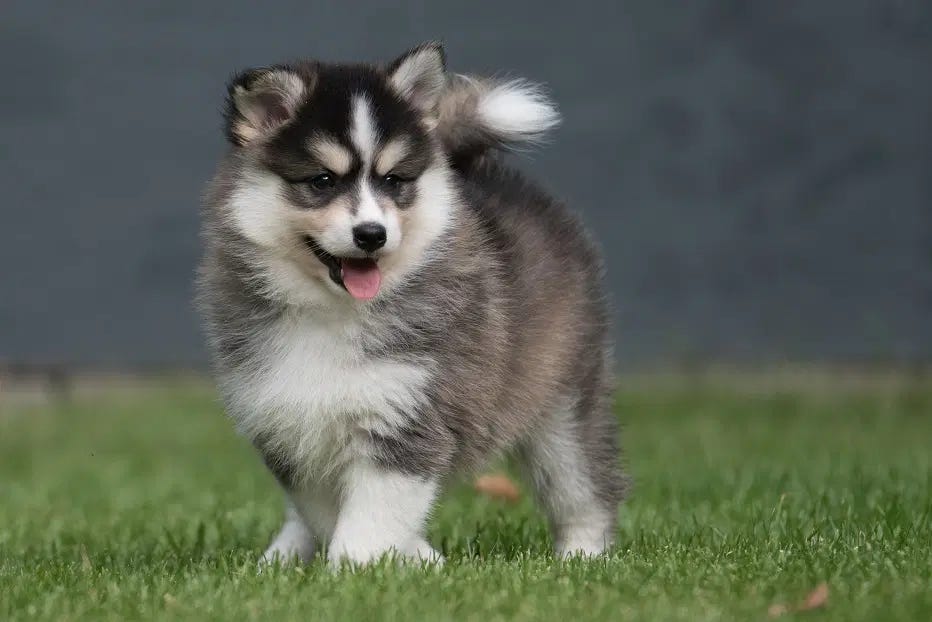Pomskies do shed, as they inherit a double coat from their Husky ancestry. They experience seasonal shedding heavily twice a year.
The Pomsky, a crossbreed between the Siberian Husky and Pomeranian, has gained popularity for its adorable appearance and manageable size. This mixed breed combines the thick fur of the Husky with the fluffiness of the Pomeranian, resulting in a dog with a dense double coat.
Pomsky owners should anticipate a moderate amount of shedding throughout the year with peaks during spring and fall. Regular grooming is essential to keep their coat healthy and to manage shedding. Acknowledging their shedding habits is key for potential owners who may have allergies or prefer a low-maintenance pet. Proper care, including brushing and diet, can help minimize shedding and ensure the Pomsky’s coat remains in top condition.
Pomsky Coat Characteristics
Exploring the Pomsky Coat Characteristics reveals insights into how this mixed breed manages their furry appearance. Pomskies inherit their coats from Siberian Huskies and Pomeranians. These traits affect their shedding patterns and grooming needs. Let’s delve into the specifics of their unique coats.
The Hybrid Vigor
The term hybrid vigor refers to the genetic principle where crossbred dogs may exhibit enhanced traits. This vigor can influence a Pomsky’s coat, potentially resulting in a healthier, more resilient fur. Although hybrid vigor doesn’t guarantee a non-shedding coat, it does contribute to the overall health and quality of their fur.
Texture And Length Variability
Pomskies showcase a range of textures and lengths in their coats. This variability comes from their diverse genetic background. Some may inherit the Husky’s thicker, longer fur, while others may carry the Pomeranian’s fluffier, shorter coat. Here’s how the coats can vary:
| Texture | Length |
|---|---|
| Soft & Fluffy | Short to Medium |
| Dense & Double-layered | Medium to Long |
Each Pomsky’s coat is unique, displaying a mix of both parents’ qualities. Regular grooming maintains their coat’s health and manages shedding.

Credit: www.facebook.com
Shedding Seasons For Pomskies
Owners often wonder about Pomsky shedding patterns. Understanding these can help in managing their fluffy coats. This post explores the shedding seasons for Pomskies, focusing on cycles and climate impact.
Understanding The Shedding Cycle
Pomskies, the adorable crossbreed of Pomeranians and Siberian Huskies, inherit a double coat. This coat has a soft underlayer and a longer, coarser topcoat. Each layer has a distinct shedding cycle. Pomskies will typically shed their undercoat twice a year— during spring and fall.
- Spring Shedding: Thins the undercoat for summer.
- Fall Shedding: Prepares for winter coat growth.
Impact Of Climate On Shedding
The climate plays a significant role in a Pomsky’s shedding frequency and intensity. In warmer climates, Pomskies may shed more consistently throughout the year. As a response to heat, shedding helps to regulate body temperature. In colder regions, the shedding cycle adjusts accordingly, retaining more fur for insulation during frigid months.
| Climate | Shedding Pattern |
|---|---|
| Warm | Year-round light shedding |
| Cold | Bi-annual intense shedding |
Regardless of the season, regular grooming is essential. Brushing your Pomsky several times a week reduces shedding and keeps their coat healthy.
Factors Influencing Pomsky Shedding
Pomsky owners often wonder about their pet’s shedding habits. Shedding in Pomsky dogs is a natural process. Many factors influence the amount of hair they shed. Understanding these factors helps predict shedding levels. Owners can better manage it this way. Let’s explore the key elements that affect Pomsky shedding.
Genetics And Parent Breeds
The Pomsky is a mix of two breeds: the Pomeranian and the Siberian Husky. Both parent breeds have distinct shedding patterns. The Pomeranian has a thick, fluffy coat. It sheds moderately. The Siberian Husky has a denser coat for cold climates. Huskies tend to shed heavily, especially during their shedding season.
Pomskies may inherit any combination of their parents’ coats. This mix determines their shedding. Some Pomskies shed like Huskies, others more like Pomeranians. It all depends on genetic makeup.
Health And Nutrition Elements
Good health and proper nutrition can lessen shedding in Pomskies. A well-balanced diet supports a healthy coat. Essential nutrients strengthen fur, reducing shed levels.
On the contrary, lack of nutrients affects the coat’s health. It leads to increased shedding. Quality dog food and supplements are important. They ensure your Pomsky’s coat stays healthy.
Regular vet check-ups are critical. They keep your Pomsky in top shape. Healthy dogs shed less. A check on skin infections or allergies is also necessary. These could cause more shedding.
Grooming Tips For Pomsky Owners
Attending to your Pomsky’s luscious coat is a joy for any pet parent. These adorable furballs, a cross between Pomeranians and Huskies, flaunt a thick, luxurious coat that requires regular grooming. Delve into these essential grooming tips to keep your Pomsky’s fur soft, shiny, and healthy.
Brushing And Combing Techniques
Regular brushing keeps your Pomsky’s coat tangle-free.
Pick a brush suited for double-coated breeds. Use it several times a week.
- Start with gentle strokes to avoid pulling the fur.
- Move in the direction of hair growth.
- Pay close attention to the undercoat.
- Use a comb for finishing touches.
Consistent brushing minimizes shedding and distributes natural oils.
Bathing And Skin Care
Bathing your Pomsky is equally vital.
- Choose a mild dog shampoo.
- Lukewarm water works best.
- Rinse thoroughly to avoid residue.
- Pamper their skin with a hydrating conditioner.
Dry them with a soft towel or a low-heat hairdryer. This helps prevent skin issues. Bathe your Pomsky every few months to maintain coat health.
Minimizing Shedding In Pomskies
Owners of Pomskies know that these fluffy companions bring joy and energy into a home. Yet, their beautiful coats come with the reality of shedding.
Understanding and reducing shedding in Pomskies ensures a cleaner home and a happier, healthier dog.
Dietary Strategies
Balanced nutrition significantly impacts a Pomsky’s coat health and shedding. Including essential fatty acids like omega-3 and omega-6 in their diet promotes a glossy, strong coat and can minimize excessive shedding.
- Feed quality dog food – Look for food that lists meat as the first ingredient.
- Add supplements – Fish oils like salmon oil can be an excellent addition.
- Stay hydrated – Ensure constant access to clean water.
Regular Exercise And Its Benefits
Exercise isn’t just good for a Pomsky’s body; it benefits their skin and coat too. Regular activity helps to distribute natural oils throughout their coat, reducing the amount of hair they shed.
Consider these exercise tips:
| Activity | Benefits |
|---|---|
| Daily walks | Distributes oils, reduces stress. |
| Playtime | Stimulates skin, releases energy. |
| Swimming | Excellent for coat, low impact. |

Credit: mystart.com
Frequently Asked Questions For Do Pomsky Shed
Do Pomsky Dogs Shed A Lot?
Pomsky dogs are moderate shedders. They shed their dense, fluffy undercoat, especially during the changing seasons. Regular grooming can help manage the shedding.
What Is The Best Way To Manage Pomsky Shedding?
Regular brushing, at least twice a week, is the best way to manage Pomsky shedding. Investing in a good de-shedding tool can significantly reduce loose fur.
How Often Should You Groom A Pomsky?
Pomskies should be groomed at least once every three weeks. During shedding seasons, more frequent grooming may be necessary to keep their coat healthy.
Are Pomskies Considered Hypoallergenic?
No, Pomskies are not considered hypoallergenic. They produce dander and shed, which can trigger allergies in sensitive individuals.
Conclusion
Understanding the shedding patterns of your Pomsky is crucial for pet care. These adorable hybrids do shed, often seasonally. Regular grooming and proper nutrition can mitigate the fluff fallout. Embrace the routine to keep your furry friend, and your home, looking their best.
Love your Pomsky, shed and all!

